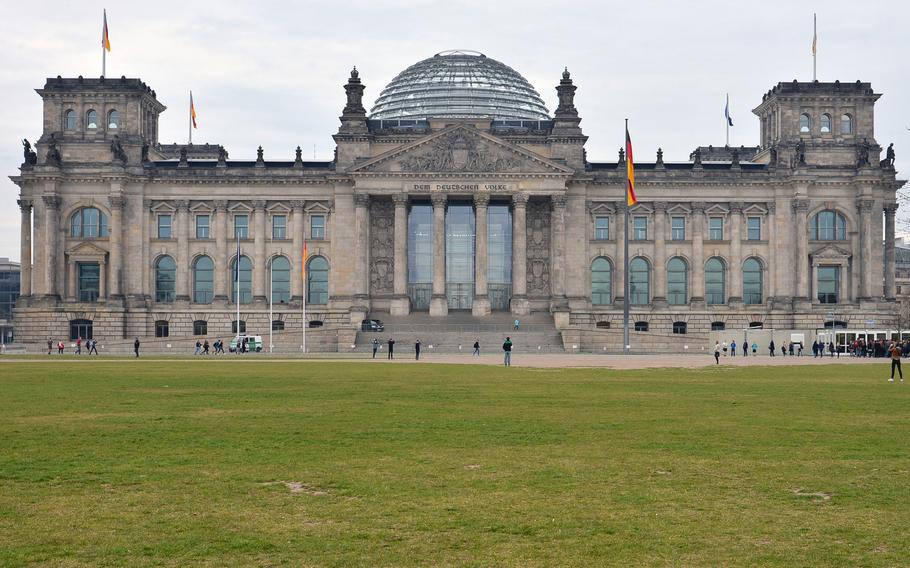
Home to the German parliament, the Reichstag burned under mysterious circumstances in 1933 just four weeks after Adolf Hitler took power. Soviet troops captured the Reichstag in April 1945 after fierce room-to-room fighting with SS and Hitler Youth fanatics. After German reunification, the Reichstag was thoroughly renovated as home to Germany's parliament and symbol of German democracy. (Michael Abrams/Stars and Stripes)
It is one of Berlin’s most popular tourist attractions. Some come to see democracy in action, but most come to wander up through the lofty glass and metal dome that crowns it.
The Reichstag is the seat of German parliament. Designed by Paul Wallot, it opened in 1894. Following World War I, Philipp Scheidemann proclaimed a republic from one of its balconies on Nov. 9, 1918.
In 1933, a month after Adolf Hitler had become chancellor, it was damaged by a mysterious fire, which was used as a pretext by the Nazis to hunt down political opponents. The building was further damaged during the battle for Berlin in 1945.
It long stood unused before being restored in 1973 and used as an exhibition hall.
After the 1990 reunification of Germany, and being wrapped in cloth by the artists Christo and Jeanne-Claude in 1995, it was completely renovated and opened for parliament in 1999 with the cupola designed by Norman Foster.
To visit the dome, you first have to go through an airport-like security check in front of the Reichstag, then you are escorted to the building and to an elevator that takes you to the roof.
From here, you glimpse the first great views of Berlin. But as you walk the steel ramp that spirals up through the cupola, it only gets better.
To the west, the view is the grassy expanse of the Platz der Republik, the gleaming Federal Chancellery building, the Victory Column and way off in the distance, the Teufelsberg, a recreation area topped by a former American radar station.
The view to the south is across the Tiergarten park to Potsdamer Platz, the Memorial to the Murdered Jews of Europe, the U.S. Embassy and the Brandenburg gate.
Looking east you see the Berlin Cathedral, the Rotes Rathaus — Berlin’s city hall — and the Television Tower on Alexanderplatz, the city’s tallest structure.
To the north are more government buildings, the Charité hospital and the gleaming Hauptbahnhof.
As great as the views over Berlin are, the one inside the dome is no less fascinating. It is 40 meters (131.234 feet) in diameter and 23.5 meters (77.09974 feet) high. Its steel and glass weighs 800 metric tons (881.849 U.S. tons).
At its center is a giant mirrored cone used to draw light into the plenary chamber below.
The glass dome above the assembly symbolizes a transparent government and that the republic’s people are above it.
At the top of the cone is the upper viewing platform, where with a spin of your body you can have a 360-degree view of the German capital.
Another spiral ramp takes you back down to roof level, where there is a restaurant with a view to the east.
From the roof, one can look down into the Reichstag’s two inner courtyards. In one, you can see a work of art called “Der Bevölkerung” (For the People), conceived by artist Hans Haacke. The soil surrounding the neon lights that make up the words were brought by the parliamentarians from their local constituencies.
If you look closely at the building’s stone walls you might be able to spot WWII bullet holes and graffiti left by Soviet soldiers.
There might be better views of Berlin — the one from the Television Tower comes to mind — but none are quite as fascinating as seeing the capital of Germany through the glass dome high above the parliament that governs it.
The Reichstag, Berlin
DIRECTIONS The Reichstag is at Platz der Republik 1, 11011 Berlin. Bus lines 100 and M85 stop at the Reichstag, while TXL, the bus from Tegel airport, stops nearby at Marschallbrücke. On subway U55 from the Hauptbahnhof, get off at the Bundestag stop.
TIMES The dome is open daily except Dec. 24 and 31 from 8 a.m. to midnight. Visitors must register online for a reservation. It is sometimes closed for cleaning and renovation, so check www.bundestag.de/htdocs_e/visits/kuppel, where you also register, to make sure it is open. If you visit spontaneously, go to the office next to the souvenir shop, where you can register if there is an opening.
COSTS Entrance is free.
FOOD The rooftop restaurant is open daily from 9 a.m. to 4:30 p.m. and 6:30 p.m. to 10:30 p.m.